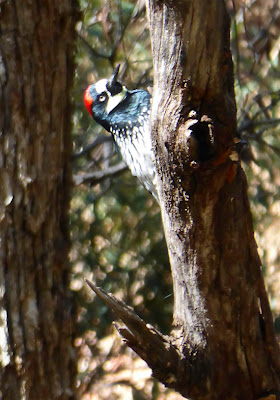Enjoy the autumn flowers!
Dave shows us grasses. (All photos by Narca)
Elaine's love of plants shines in all she says.
Chiricahua Mountain Columbine, Aquilegia triternata
This beauty quietly graces the shaded canyons of southeastern Arizona and adjacent New Mexico.
Arizona Madrone, Arbutus arizonica
Late-fall berries from this handsome tree are relished by trogons, quetzals, thrushes and sapsuckers. Arizona Madrone is a tree of the Sky Islands of Arizona and New Mexico. The bulk of its range lies in the Sierra Madre Occidental of Mexico.
The graceful Birdbill Dayflower, Commelina dianthifolia
A common native to several Western states and northern Mexico, this lovely herb favors open meadows and forest floors, where it blooms from summer to fall. You can find it all the way from South Fork up to the higher elevations of the Chiricahua Mountains.
Hummingbird Trumpet, Epilobium canum
The name says it all! Native to dry slopes of western North America, especially California, this beautiful willowherb produces a profusion of scarlet flowers in summer and fall. Gardeners find it easy to grow, and thus they earn the gratitude of hummingbirds.
Richardson's Geranium, Geranium richardsonii
A familiar flower to all who roam the Chiricahuas––and generally, to those who roam the West, all the way north to Alaska.
Huachuca Mountain Geranium, Geranium wislizeni
I hadn't realized that we have a second geranium, growing alongside Richardson's! Huachuca Mountain Geranium flowers in August and September, in oak-juniper woodlands.
Dakota Mock Vervain, Glandularia bipinnatifida
This verbena is native to the U.S., south to Nicaragua. In the U.S., it is most abundant in the prairies of the Great Plains––it is likely one more example of a Plains Grassland species that became established in our region during an earlier, wetter period, and persists today where conditions allow.
Mock Pennyroyal, Hedeoma hyssopifolia
This fragrant mint flowers from May to October in rocky canyons of Arizona, New Mexico and northern Mexico.
Macomb's Trumpet, Ipomopsis macombii
Macomb's Trumpet is a very beautiful perennial of southern Arizona, New Mexico and Texas, and northern Mexico. Its genus name, Ipomopsis, is Greek for "striking appearance."
Plains Beebalm, Monarda pectinata
Monarda––another very fragrant mint––attracts hummingbirds, butterflies and bees. It grows from 4000-8000'.
Rabbitsfoot Grass, Polypogon monspeliensis
A non-native, widespread annual, Rabbitsfoot colonizes disturbed soil. We saw very few in South Fork, and those were likely brought in with road repairs after Hurricane Odile set its sights on the Chiricahuas.
Birchleaf Buckthorn, Rhamnus betulifolia
A common shrub of moist canyons in the Southwest and Mexico, Birchleaf Buckthorn provides browse for deer and berries for birds.
Fragrant Sumac or Lemonadeberry, Rhus aromatica
The berries are tart and tasty! Lemonadeberry is a good shrub to learn, as it's widespread in the U.S. Its medicinal uses are legion.
Caliche Globemallow, Sphaeralcea laxa
This globemallow grows on rocky slopes and in washes, especially in caliche soils. You've no doubt encountered it at lower elevations in the Chiricahuas.
One of my favorites, Torrey's Craglily, Echeandia flavescens
Torrey's Craglily graces woodlands and grasslands from Arizona, New Mexico and West Texas, south through Mexico.
Toothleaf Goldeneye, Viguiera dentata
What would Arizona be, without its wonderful, sunny displays of hard-to-identify composites? Toothleaf Goldeneye thrives in dry canyons, from Arizona and New Mexico, all the way south to Central America. In Mexico, infusions made from this goldeneye are used to treat baby rash; its essential oils have antibiotic properties.
Next year at Heritage Days, come join our wildflower walk!























































